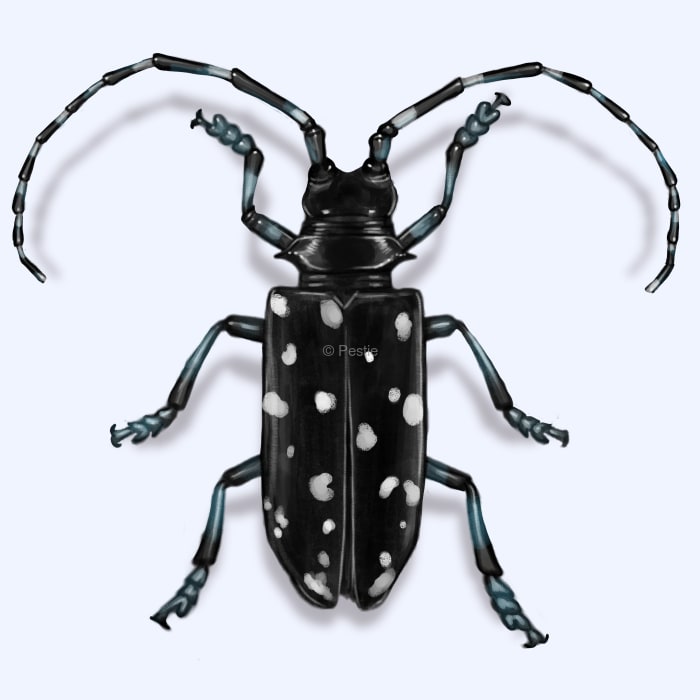How to identify and get rid of longhorn beetles

Understanding longhorn beetles: identification tips and control strategies
If a beetle was ever made for Texas, it has to be the longhorn beetle. These wood-boring beetles have impressively long antennae that are often longer than their body.
Most species lay their eggs into dead, dying, or living trees, and the larvae hatch and begin digging into the wood. Due to their large heads and tapered bodies, the larvae are often called roundheaded borers.
The larvae eat wood and plant tissues inside the tree or plant and can cause significant damage. Several species of longhorn beetle are invasive and cause millions of dollars in damage to the timber industry. These same beetles can also kill healthy trees in parks and yards.
However, there are thousands of species of longhorn beetles in the US, and only a handful are serious pests. The old house borer is one longhorn beetle that isn’t very common but can still cause structural damage to a home. As its name implies, the old house borer is primarily a pest of softwood timber in older homes.
How to identify longhorn beetles
Longhorn beetles are best identified by their incredibly long antennae. They come in various sizes and colors, but their antennae are almost always as long as their body.
The larvae are grub-like with a creamy color. They have a tapered body with a large head.
If you notice these beetles around, especially near dead or dying trees, it could signal an infestation. Signs of their presence include boreholes in tree bark, a sawdust-like substance around the tree base or branches, and weakening or dead branches.
How big are longhorn beetles?
Longhorn beetles range from 0.75 to 1.5 inches long, depending on the species.
What other pest looks like a longhorn beetle?
Longhorn beetles may be confused with other wood-boring beetles, but their unusually long antennae and size generally set them apart. Beetles like the emerald ash borer or bark beetles also infest trees but are much smaller and less conspicuous. Longhorn beetles have a similar size, shape, color to fireflies.
Where do longhorn beetles live?
Longhorn beetles are found throughout the United States, inhabiting forests, parks, gardens, and wooded areas.
How to get rid of longhorn beetles
Longhorn beetles can be very difficult to deal with since they are safely tucked away inside trees or other plants and can’t be easily recognized or treated. If you suspect you might have a longhorn beetle problem, the best thing to do is sanitation and prevention.
Here are a few ideas to keep your trees from becoming infected with longhorn beetles:
- Remove infested wood: Promptly dispose of any dead or dying wood where beetles can breed.
- Maintain tree health: Healthy trees are less likely to be infested, so properly water, mulch, and prune your trees as needed.
- Use physical barriers: Wrap young trees or put up physical barriers to prevent beetles from laying eggs on them.
- Monitor regularly: Watch your trees for early signs of infestation to manage them before serious damage occurs.
Additionally, you can use an insect barrier spray around your property to prevent longhorn beetles from entering your home or yard. Pestie offers a pro-grade DIY solution delivered to your doorstep. Check out our subscription plan to save on your pest control this year!
Treat longhorn beetles with Pestie
If you're still having trouble keeping longhorn beetles away, the best option is to use a pro-grade, effective pest control solution like Pestie.
Pestie is a do-it-yourself pest control solution that's specially designed to keep longhorn beetles and other pests away from your home.
With Pestie, you can rest easy knowing that your living space is protected and free of creepy crawlies. And the best part? It's designed for people, pets, and the planet, so you can say goodbye to harsh chemicals and hello to peace of mind!
- Save hundreds compared to traditional annual pest plans
- People, pet, and planet-friendly
- Pro-grade customized formulas
Quick facts
How dangerous are Longhorn Beetles?
Medium danger risk
While longhorn beetles aren’t dangerous to humans, they can damage and kill trees in your yard.
- Scientific name
Family - Cerambycidae
- Other common names
Long-horned, Longicorns, Roundheaded Borers
- Colors
Diverse, ranging from dull browns to vibrant colors with complex patterns
- Life span
1-2 years
- Diet
Wood and plant tissue
Longhorn beetles are strongly attracted to particular smells that trees give off. Some species can even tell if other beetles are infesting the tree just by the smell.








